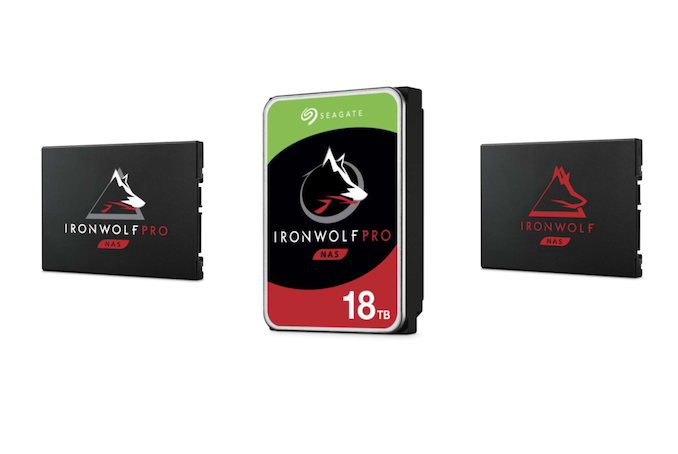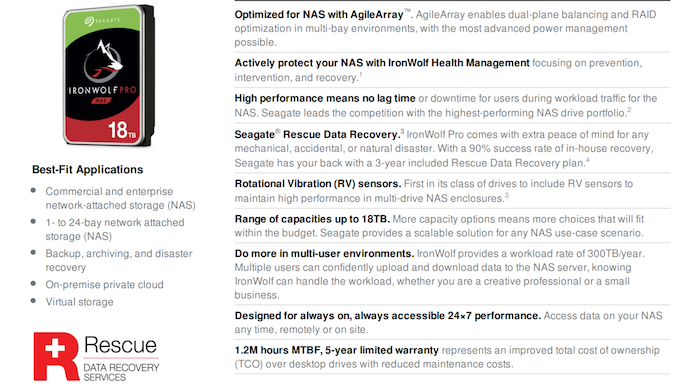Seagate Updates IronWolf NAS Drives Lineup with 18TB Pro HDD and New 4TB SSDs
by Ganesh T S on September 1, 2020 11:30 AM EST
Seagate is introducing new flagships in their IronWolf lineup today on two fronts - the SMB/SME-focused IronWolf Pro, and the SATA SSDs line. On the HDD front, we have 18TB hard drives based on conventional magnetic recording (CMR) technology, while the SATA SSD line sees two new SKU sets - the IronWolf 125 and the IronWolf Pro 125 (joining the current IronWolf 110 and the NVMe-based IronWolf 510).
Given the premium nature of the 18TB capacity point, Seagate is launching the capacity only in the IronWolf Pro line (the vanilla IronWolf models top out at 16TB). The ST18000NE000 18TB Pro model is compatible with NAS units of up to 24 bays, and has a workload rating of 300TB/yr. It is a 7200 rpm 9-platter helium-filled drive, with a DRAM cache of 256MB (which seems to be half of what is offered by Western Digital in their Gold line of enterprise hard drives - the other 18TB choice in the retail market). The drive comes with a 5-year warranty and is rated for 24x7 operation, with a MTTF of 1.2M hours.
The average power consumption sees an increase from 7.6W for the 16TB model to 8W for the 18TB version. The drive does use TDMR technology for the heads, and we have reached out to Seagate for information on possible HAMR usage (Update: HAMR is NOT used in the IronWolf Pro 18TB).
The new SATA SSDs are 2.5" drives with different optimizations for varying use-cases. The IronWolf 125 is meant as a capacity play - available in capacities ranging from 250GB all the way to 4TB. It comes with a 0.7DWPD rating, and no power-loss protection. On the other hand, the IronWolf Pro 125 has a 1DWPD rating, more over-provisioning (rated capacities range from 240GB to 3.84TB), and comes with power-loss protection. The Pro drives come with a 2M hour MTTF, while the corresponding metric is 1.8M hours for the non-Pro version. Both drives come with a 5-year warranty, with the Pro series including a 3-year data recovery service.
| The Seagate IronWolf 125 SSDs for NAS | ||||||
| Capacity | 250 GB | 500 GB | 1 TB | 2 TB | 4 TB | |
| Controller | Phison S12 (Seagate-validated) | |||||
| NAND Flash | 3D TLC NAND | |||||
| Form-Factor, Interface | 2.5" x 7mm, SATA III 6 Gbps | |||||
| Seq. Read (128KB @ QD32) | 560 MBps | |||||
| Seq. Write (128KB @ QD32) | 540 MBps | |||||
| Rand. Read IOPS (QD32T8) | 95K | |||||
| Rand. Write IOPS (QD32T8) (Peak) | 90K | |||||
| Pseudo-SLC Caching | Yes | |||||
| DRAM Buffer | Yes (Size?) | |||||
| TCG Opal Encryption | No | |||||
| Power Consumption | Avg Active | 2.3 W | 2.4 W | 2.6 W | 2.8 W | |
| Avg Idle | 0.11 W | 0.115 W | 0.13 W | 0.14 W | ||
| Warranty | 5 years | |||||
| MTBF | 1.8 million hours | |||||
| TBW | 300 | 700 | 1400 | 2800 | 5600 | |
| DWPD | 0.7 | |||||
| UBER | 1E10^17 | |||||
| Additional Information | Link | |||||
| MSRP | $63 | $84 | $142 | $294 | $609 | |
| The Seagate IronWolf Pro 125 SSDs for NAS | ||||||
| Capacity | 240 GB | 480 GB | 960 GB | 1920 GB | 3840 GB | |
| Controller | Phison S12DC (Seagate-validated) | |||||
| NAND Flash | 3D TLC NAND | |||||
| Form-Factor, Interface | 2.5" x 7mm, SATA III 6 Gbps | |||||
| Seq. Read (128KB @ QD32) | 545 MBps | |||||
| Seq. Write (128KB @ QD32) | 360 MBps | 500 MBps | 520 MBps | |||
| Rand. Read IOPS (QD32T8) | 90K | 96K | ||||
| Rand. Write IOPS (QD32T8) (Sustained) | 12K | 16K | 25K | 30K | ||
| Pseudo-SLC Caching | No | |||||
| DRAM Buffer | Yes (Size?) | |||||
| TCG Opal Encryption | No | |||||
| Power Consumption | Avg Active | 2.5 W | 3 W | 4 W | 4.4 W | 5 W |
| Avg Idle | 1.4 W | 1.6 W | 1.8 W | 1.9 W | ||
| Warranty | 5 years (including 3 years of Rescue Data Recovery Services) | |||||
| MTBF | 2 million hours | |||||
| TBW | 435 | 875 | 1750 | 3500 | 7000 | |
| DWPD | 1 | |||||
| UBER | 1E10^17 | |||||
| Additional Information | Link | |||||
| MSRP | $98 | $146 | $264 | $474 | $888 | |
The new IronWolf Pro 18TB HDD is priced at $609 (compared to $593 for the equivalent WD Gold drive). Pricing for the different models in the IronWolf (Pro) 125 SSD series is available in the tables above. The main competition here is Western Digital's WD Red SA500 series. Seagate does more product segmentation / firmware tweaking for the NAS SSD market, allowing consumers to choose a SSD tuned for their requirements.
Source: Seagate











13 Comments
View All Comments
Chaitanya - Tuesday, September 1, 2020 - link
Curious about platter density of that 18TB drive.e36Jeff - Tuesday, September 1, 2020 - link
it would be 2TB/platter. 18TB with 9 platters.LordConrad - Wednesday, September 2, 2020 - link
"The ST18000NE000 18TB Pro model is compatible with NAS units of up to 24 bays, and has a workload rating of 300TB/yr. It is a 7200 rpm 9-platter helium-filled drive, with a DRAM cache of 256MB (which seems to be half of what is offered by Western Digital in their Gold line of enterprise hard drives - the other 18TB choice in the retail market)."Bad comparison, WD Gold drives are not sold or rated for use in a NAS.
ganeshts - Wednesday, September 2, 2020 - link
They are meant for use in datacenter environments, similar to the Exos drives. They are an overkill for consumer / SMB / SME NAS units, but are more than good enough to use in such NAS boxes (they tick all the boxes for RV sensors, TLER etc.)m4063 - Saturday, December 11, 2021 - link
Be aware their IronWolf SSD does NOT have TLER! :-(cjl - Wednesday, September 2, 2020 - link
Enterprise drives (WD Gold or Seagate Exos) are a higher tier of qualification than NAS. They meet all NAS requirements and then some.mgutt - Wednesday, September 2, 2020 - link
After the high failure rate of the 16TB version (see Backblaze Q2 2020) I will wait how reliable those big drives are over time.manicmatviyko - Wednesday, September 2, 2020 - link
@mgutt, the Backblaze reference you provided was quite kind to the Seagate Exos-branded line...specifically, the 16TB unit that haunts your sleep (ST16000NM001G). Actually...since 2017, Blackblaze's AFR has been predictably stable for the Seagate high-capacity spinners; might wanna give that source of yours a double check!## https://www.backblaze.com/blog/backblaze-hard-driv...
"3. Seagate: After a steady rise in AFR, the last two quarters have been kind to Seagate, with the most recent quarter (AFR = 0.90%) being the best we have ever seen from Seagate since we started keeping stats back in 2013. Good news and worthy of a deeper look over the coming months."
Zoolook - Friday, September 4, 2020 - link
Maybe you should have read the report in your link 6,73% AFR for the Seagate 16TB, that's horrible.OxygenVendor - Saturday, September 5, 2020 - link
Your quick to write off an entire product line from seeing AFR%. Only 1 of 59 drives failed and it was their smallest drive count. The general likelihood is the AFR% falls back in line with the rest of the models as the sample size increases.